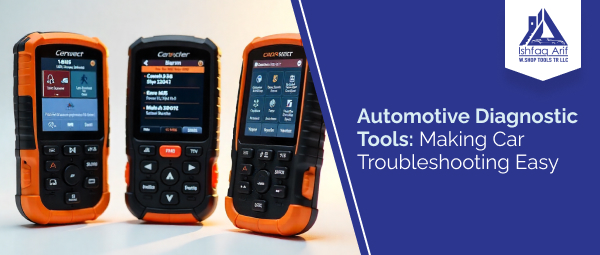
Have a Question? :
+971 55 7841839 +971 55 4252676 +971 6 523 7022
Login / Register

26 Sep, 2025, 10:58 AM

Nowadays, cars do not always represent mere machines; they are intelligent devices. As cars become increasingly electronically powered and equipped with numerous sensors, it has become critical to gain insight into what is happening beneath the hood with appropriate tools. This is where the car diagnostics apparatus comes into play. These devices make life easier for both mechanics and car owners since they assist in identifying the problem in a vehicle with high accuracy and within a short time.
Car diagnostics tools are a new standard in the sphere of car care. Use these handy tools as an educated driver or even a professional mechanic and save some time, money, and guesswork. Cars are gradually becoming more electronic, and getting such a tool is a good choice to take care of them better and ensure safety on the road.
Automotive diagnostics are electronic gadgets or computerized programs that scan, read, and interpret error signals in the on-board computers of automobiles. Such devices plug into the OBD-II (On-Board Diagnostics) interface on a vehicle, which is typically on the dashboard. When they are linked, they receive information from different sensors and control systems in the vehicle.
The current cars are equipped with tens of electronic systems that interact with one another, such as the engine control unit (ECU), transmission, ABS brakes, airbag systems, etc. When there is a failure, a code known as a DTC (Diagnostic Trouble Code) is stored by the system. These codes are read by the diagnostic tools to describe the problem. Other sophisticated devices also present real-time information, e.g., engine temperature, fuel pressure, and oxygen sensor readings.
Automotive diagnostic tools come in several types that are available in the market. The common ones are:
OBD-II code readers: These read and clear codes. They are low-cost and suitable for use at home.
Scan Tools: These possess even superior functionalities like live data monitoring, graphs, and system tests. They are mostly used by professional mechanics.
Bluetooth/Wi-Fi Adapters: They are plugged into the OBD-II port, and the mobile connection is achievable through a wireless connection using applications on smartphones or tablets. They are very compact and convenient to use.
OEM-specific tools: These tools are supplied by car manufacturers and have in-depth diagnostics on the specific makes and models.
Time Saving: These tools save time by highlighting the problem area quickly and leaving less time for troubleshooting.
Economic: The car owners may know the existence of minor problems, which might lead to skipping a visit to the workshop.
Accuracy: Sophisticated diagnostic equipment gives critical results that aid in making adequate corrections.
Preventive Maintenance: This is when some of the gadgets warn the user regarding a problem that will occur later, which means less maintenance of the vehicle.
Who Are The Users Of The Tools?
Although these devices are primarily used by mechanics and auto repair shops, automotive diagnostic tools are widely used by car enthusiasts and car owners to perform simple tests. This will assist in knowing when a warning light is really wrong or merely a small adjustment.